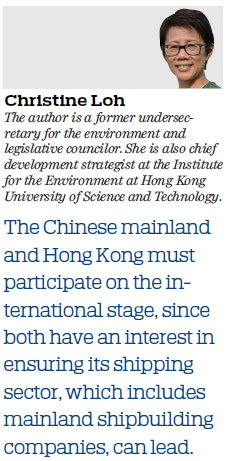HKSAR needs bold maritime plan to complement the Bay Area vision
Updated: 2019-05-02 07:42
By Christine Loh(HK Edition)
|
|||||||||
Anyone looking at Victoria Harbour can see many fascinating activities going on - ocean-going vessels (OGVs) docked at Kwai Chung terminals loading and unloading cargoes, cruise ships berthed at Kai Tak, large ships moored in nearby waters, plus a host of other smaller vessels, such as barges, hydrofoils and ferries plying the waters.
News reports note that Hong Kong has slipped from being once the world's busiest container port to 7th place behind Shanghai, Singapore, Shenzhen, Ningbo-Zhoushan, Busan and Guangzhou. Some estimates indicate Hong Kong might drop one more place as Qingdao advances.
Being the largest in throughput is a measure of importance, but it's not the "be all and end all" in terms of influence. After all, Hong Kong's port expanded from the 1980s on the back of the Chinese mainland's reentering global trade; and as the mainland economy expands, so do its ports.
Hong Kong has no more land to expand the physical size of the port. It should be government policy to make Hong Kong more influential in maritime affairs. This will not only be good for commerce but also important strategically for Hong Kong.
The nationally-backed Guangdong-Hong Kong-Macao Greater Bay Area plan calls on Guangdong, Hong Kong and Macao to cooperate. They should look for win-win arrangements. They should "strengthen policy coordination and planning", explore regional synergies, pursue green development and even "pool international innovation resources", plus "develop new edges in international cooperation".
The ports of Shenzhen, Guangzhou and Hong Kong make up an awesome slice of the world's total container traffic - around 10 percent. If they could pool their port-related resources into making regional facilities the most efficient, innovative and green, that would be an ambitious and worthy actualization of the national vision.

Unlike the mainland, Hong Kong's port facilities are privatized. Nevertheless, the private operators are savvy, many with international knowledge and networks. They should be engaged to consider a wider, long-term plan that will serve the people in terms of good jobs and green living. There is every reason for their business to remain profitable too.
After all, Hong Kong should be the southern Chinese international maritime center. It already has a large presence of national and international shipowners and liners, as well as ship management companies and seafarers, terminal and barge operators, cruise liners, marine fuel suppliers, ship charterers and brokers, and other essential service providers, such as financiers and lawyers. Future-looking employers will be the ones who can attract young talent.
The ferries and hydrofoil operators are part of the vision. They transport a large number of people within local and regional waters. The Bay Area can create a multilayered plan for OGVs, as well as smaller local vessels that would turn the waters of the region into an efficient, clean and pleasurable experience for all types of users.
Public policy is needed for such a transformation. For example, international shipping is pushing for lowering pollutant emissions and decarbonization of ships. The International Maritime Organization (IMO) regulates international shipping, and both the mainland and Hong Kong are members. Both can influence the pace and direction of making shipping much greener at the global level.
In the short-term and at a local-regional level, the Bay Area already has a mandate since the beginning of this year - ships entering regional waters must meet a sulphur cap of 0.5 percent. It's time to lower it to 0.1 percent. The reason is to maintain leadership. The IMO's mandate is for shipping fuels to meet a global sulphur cap of 0.5 percent by 2020. North America and northern Europe have required the use of 0.1 percent sulphur fuel for some years. The Chinese mainland is a leader in Asia, and Hong Kong has been the forerunner in promoting fuel switching since 2013.
On a global level, the IMO is also encouraging ships to reduce nitrogen oxide; and for global shipping to reduce its carbon emissions by half by 2050. The Chinese mainland and Hong Kong must participate on the international stage, since both have an interest in ensuring its shipping sector, which includes mainland shipbuilding companies, can lead. In light of climate change, any lobbying must be for higher gains and not slowing things down.
At an innovation level, Hong Kong, Macao and Guangdong have much to gain by achieving greening the multiple goals of higher efficiency, lower costs, cleaner environment, better jobs and healthier people through establishing green shipping, ports and harbors.
Just imagine if the ferries and hydrofoils serving the Bay Area are electric or hybrid. The authorities could work with operators on a scheme to replace old vessels with new ones. Furthermore, barges can also benefit from these new technologies, or switch to LNG (liquefied natural gas). The mainland is encouraging the use of LNG in shipping, and Hong Kong must provide for its bunkering on which it has no policy yet.
As for OGVs, the shipping industry is introducing new engines to reduce nitrogen oxides, and some ports are giving incentives to these ships to help the industry make the necessary investments. The Bay Area should work out a scheme to attract these ships. Furthermore, the cruise business along the Chinese coast is expected to grow by leaps and bounds. It's time to introduce a green cruising policy for the entire China coast.
If Hong Kong wants to be influential nationally and internationally, it's Transport and Housing Bureau and the Environment Bureau, which mostly work in their own silos, must cooperate in delivering a farsighted, transformational green maritime plan that complements the Bay Area vision, while enhancing Hong Kong's port status in a dawning era.
(HK Edition 05/02/2019 page5)